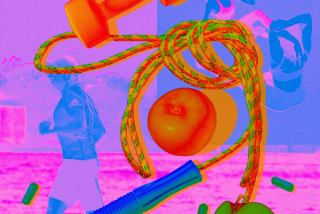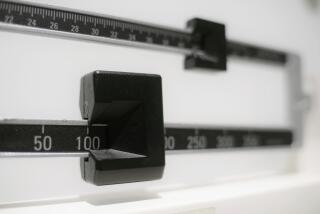Fine-Tuning the Fat Out of a Diet
- Share via
On the stock market that Kae Ewing deals with every day, numbers have a way of changing rapidly: up 14 points one minute, down 50 the next. So it’s no wonder he gets frustrated when his own weight-loss numbers are slow to change.
After dropping 14 pounds in the first two months of his new fitness program, Ewing, 55, a vice president with Shearson Lehman Hutton in Irvine, has hit a plateau. The 6-3 1/2 Lido Island resident has lost only a single pound since the first of the year, bringing his weight down to 243, far short of the 203-pound goal he set last November.
Fitness consultant Joe Dillon of Body Accounting in Irvine, who has been meeting weekly with Ewing to guide him through the program, remains encouraging. That’s still averages out to more than a pound a week, “and you lost four pounds over the holidays, when most other people are gaining weight,” he reminds Ewing.
Ewing, who agreed to let Health & Fitness readers follow his experiences, has been faithful to the low-fat, high-complex-carbohydrate diet that Dillon recommends, but he hasn’t been nearly as conscientious with his exercise program.
With his busy work schedule and social life, Ewing takes a brisk 45-minute walk with hand weights around Lido Island two or three times a week, instead of the recommended six or seven.
“I just can’t seem to get motivated,” he says.
Still, results are beginning to show.
Ewing’s face is noticeably thinner and his watch is loose on his wrist again even though he has taken it to the jeweler’s once already to have it tightened. His shirt collars are also starting to feel too big. But he hasn’t yet started shrinking around the waist.
Dillon says one factor in the slow weight loss may be that while Ewing is losing fat, he’s adding muscle. After years of a mostly sedentary life style, Ewing, a champion athlete in his youth, is feeling his legs and arms getting stronger, even with limited exercise.
Plateaus don’t happen to everyone, but they are fairly common, Dillon says. Typically, clients will stay at one weight for a month or more, then drop pounds rapidly--if they’ve been adhering to the program consistently.
Ewing hopes that will happen to him, but in the meantime, he’d like to make changes where he can to improve his chances of success.
He has decided to try listening to books on tape while he walks in hopes that the stories will motivate him to exercise regularly.
“We’ve done that in the car on trips, and it made the long drives so much easier,” says Ewing’s wife, Louise. “Maybe it will be the same for his walks. If he only allows himself to listen while he’s walking, maybe that will be the incentive he needs.”
To fine-tune his diet, Dillon took Ewing on a field trip to the local market to show him how to find healthy foods and avoid those with hidden fat, sugar, sodium and other undesirable ingredients.
A veteran dieter whose weight has boomeranged up and down for years, Ewing long ago developed the habit of checking package labels for calorie counts. But Dillon says the calorie number isn’t nearly as important as the numbers for fat and sodium.
“A calorie is not just a calorie,” he says. “The research has shown that fat calories are 98% absorbed by the body, compared with about 70% for calories from complex carbohydrates.”
In the market, Dillon and Ewing began in the frozen food aisle, where Dillon recommended sugar-free ice cream-type products, vegetables (no sauce), fruit, and frozen egg products in which the high-fat, high-cholesterol yolks had been removed.
Fat can’t be avoided entirely, but Dillon says a good rule of thumb is to eat only foods that have a fat content of 20% or less.
Many foods labeled “diet” or “light” don’t qualify, he pointed out. “Light” mayonnaise, for example, is 91% fat, compared with regular mayonnaise which is 99% fat. He passed up most of the frozen dinners also because they were too high in either fat or sodium.
In the refrigerator case, Dillon slowed down at the cheese section just long enough to pick up a package of sap sago cheese, a hard, pungent, low-fat variety that can be grated over baked potatoes and other foods to add flavor without the fat of butter or sour cream. Other dairy products he recommends include nonfat milk, yogurt and cottage cheese. Nonfat yogurt, he said, can also be used as a sour cream substitute.
Although Dillon recommends pasta as an excellent source of complex carbohydrates, he passed up the refrigerated pasta section, pointing out that those noodles were made with whole eggs and were therefore too high in fat and cholesterol. Ewing, who has been eating a lot of pasta lately, took note. Dillon recommends pasta made with water or egg whites instead.
Many pasta sauces, whether refrigerated or in jars, also have hidden fat, Dillon said. “Even the (tomato-based) marinara sauces usually have oil in them.”
Dillon recommends only two kinds of meat: sliced turkey (ground turkey is 45% fat, he says) and chicken breasts.
In the beverage section, he suggests bottled water, flavored or unflavored, juice/water combinations (“but you have to look at the label to see if they’ve added sugar or fructose”), herb teas and decaffeinated tea.
Although he prefers diet, caffeine-free sodas to their high-sugar counterparts, Dillon says that Nutrasweet, the artificial sweetener in those beverages, “can be a powerful appetite stimulant for some people.”
“No cookies. Period,” Dillon said as he and Ewing steered their cart past that section. But he stopped in front of the breads, recommending most forms as good sources of complex carbohydrates. He also recommended rice, popcorn (no salt or butter) and some kinds of crackers.
Any form of cereal that is not presweetened is acceptable, Dillon said. Corn tortillas are also good, but he says most flour tortillas are made with lard and are too high in fat. Legumes, such as beans, peas and lentil, are perfect, as are rice cakes for snacking.
If all this sounds too bland, Dillon has a remedy to add spice to your life.
Instead of salt, he recommends the many salt-free spices available--even imitation butter flavoring for those who feel they can’t do without the taste. “Most spices are good if you avoid the ones mixed with salt. Use garlic powder, for example, instead of garlic salt.”
“How about fresh garlic?” Ewing asked.
“That’s fine,” Dillon said.
Other low-fat additions that can make food more flavorful include mustards, salsas and flavored vinegars, he said.
Salads are good, but most salad dressings contain so much oil that they can counteract the benefit of the fresh greens. Dillon only recommends salad dressing made without oil.
As they passed the cooking oil section, Dillon waved toward the shelves and said, “Try to think of this as pure fat, because that’s what it is.”
Spray-on oils are better, if you must use oil for cooking, but Dillon says it’s better to use a no-stick skillet and no oil if possible.
Soups can be good, but not if they contain too much sodium. Even the low-sodium varieties of the most popular brands contain too much salt, Dillon says. “Sodium is also a powerful appetite stimulant,” he said. “So is sugar.”
Finally, the two arrived at Dillon’s favorite section: fresh produce. Here, instead of pointing out the few acceptable items, Dillon simply noted the two unacceptable foods: avocadoes and olives (both too high in fat).
Potatoes are an especially good food for dieters, he said, as long as you stay away from the butter and sour cream. “Eating a lot of potatoes is a really aggressive way to lose weight.”
Ewing began filling bags with several varieties of potatoes. “I’m going to try it,” he said.


